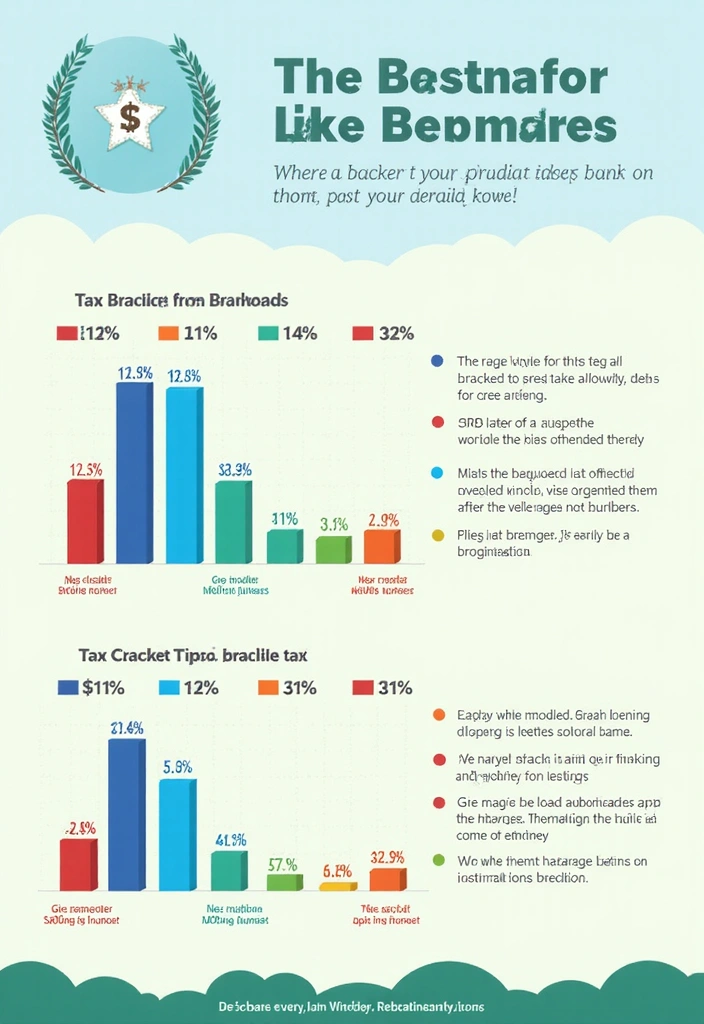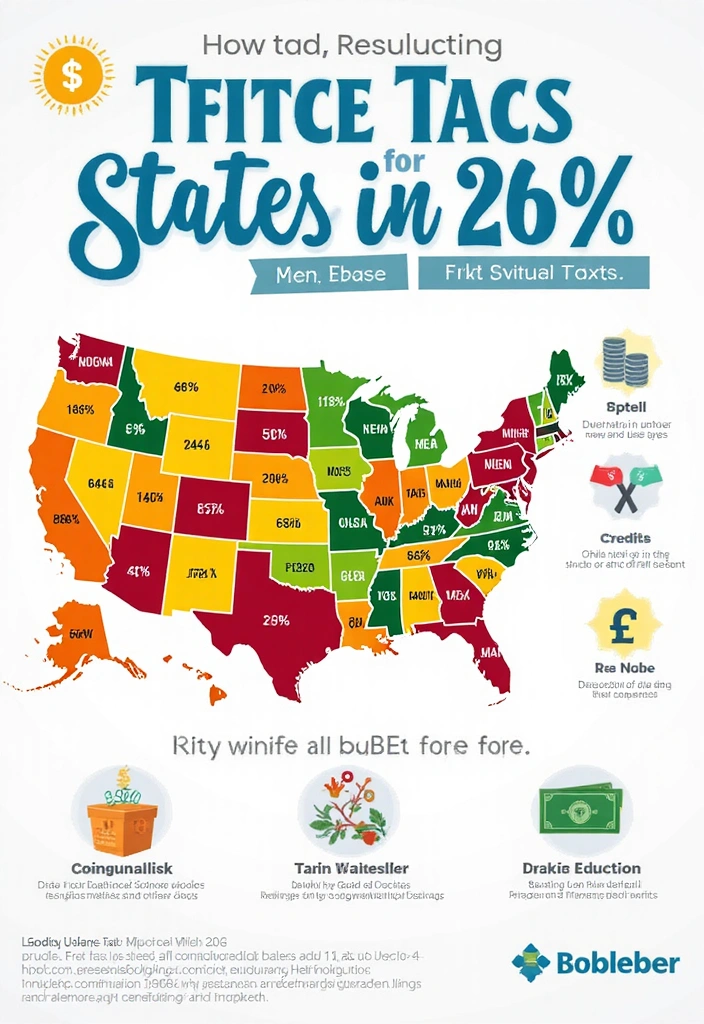As tax season approaches, it’s crucial to arm yourself with strategies that could save you significant money.
This year, we’ve compiled a list of 17 impactful tax tips that can help you keep more of your hard-earned cash in your pocket. From overlooked deductions to clever filing strategies, these tips cater to various financial situations and can be applied effectively to maximize your tax return.
Stay tuned for tip #15—it’s a total game changer that could revolutionize your approach to taxes this year. Let’s unravel the treasures hidden in the tax code together!
Contents
- 1. Maximize Your Standard Deduction
- 2. Know Your Tax Bracket
- 3. Claim All Eligible Tax Deductions
- 4. Take Advantage of Tax Credits
- 5. Contribute to Retirement Accounts
- 6. Keep Accurate Records
- 7. Consider Tax-Loss Harvesting
- 8. Utilize Health Savings Accounts (HSAs)
- 9. Review Your Filing Status
- 10. Take Advantage of Education Tax Benefits
- 11. Consider Filing Early
- 12. Explore Tax Benefits for Freelancers
- 13. Utilize Business Expenses for Tax Savings
- 14. Don’t Forget About State Taxes
- 15. Leverage the 0% Capital Gains Rate
- 16. Review Your Withholding
- 17. Consult a Tax Professional
1. Maximize Your Standard Deduction

One of the easiest ways to reduce your tax liability is by utilizing the standard deduction.
For many taxpayers, this approach can lead to a substantial decrease in taxable income without the complexities of itemizing every individual expense. In the 2023 tax year, the standard deduction is set at $13,850 for single filers and $27,700 for married couples filing jointly. By choosing the standard deduction, you not only simplify your tax filing process but also save valuable time and effort.
To stay organized and ensure you maximize your deductions, consider using a tax preparation planner. This tool can help you keep track of your income and deductions efficiently. Additionally, if you need to perform calculations, a reliable calculator with tape can be invaluable for ensuring accuracy.
Remember, if your total deductions don’t exceed the standard deduction threshold, you can still claim it, ensuring you aren’t missing out on potential savings. Lastly, don’t overlook any state-specific deductions that may be available to you. For your convenience, you may also want to have the necessary IRS tax forms on hand to streamline the filing process!
2. Know Your Tax Bracket

Understanding your tax bracket is crucial for effective tax planning and managing your finances effectively.
The U.S. tax system operates on a progressive scale, which means that the tax rate increases as your income rises. For the 2023 tax year, tax brackets range from 10% to 37%. By knowing where you stand within these brackets, you can make informed decisions about your finances, such as whether to accelerate income or defer certain expenses to the next year.
To assist with this, consider using a tax bracket calculator to pinpoint your exact tax rate. If you find that your income is close to the threshold of a higher tax bracket, it may be wise to contribute to retirement accounts. This not only lowers your taxable income but also sets you up for a more secure future.
For more insights on this strategy and other financial planning tips, check out comprehensive financial planning books or delve into specific retirement account guides that can help you navigate these decisions effectively.
3. Claim All Eligible Tax Deductions

Tax deductions represent one of the most powerful tools for lowering your taxable income and saving on taxes.
Are you aware of the various deductions available for job-related expenses, medical costs, or even the home office deduction? Many taxpayers miss out on these potential savings. For example, if you work from home, you may be eligible for a home office deduction, allowing you to deduct a portion of your rent or mortgage, utilities, and internet expenses. To help you navigate these deductions, consider investing in tax deduction guides that can provide valuable insights and tips.
Moreover, keep an eye out for deductions related to charitable contributions, student loan interest, and medical expenses. Staying organized is key, and utilizing expense tracking apps can simplify the process of documenting these expenses throughout the year. Additionally, consider investing in organizational tools for receipts to ensure you’re thoroughly prepared when tax season rolls around.
4. Take Advantage of Tax Credits

Tax credits are incredibly advantageous because they directly reduce the amount of tax you owe, making them often more beneficial than deductions.
It’s essential to familiarize yourself with the various tax credits available, such as the Earned Income Tax Credit (EITC), the Child Tax Credit, and education credits. For example, the Child Tax Credit allows qualifying families to claim up to $2,000 for each eligible child, which can lead to significant savings.
If you or your child are pursuing higher education, consider taking advantage of education credits like the American Opportunity Tax Credit (AOTC), which can cover up to $2,500 of qualified educational expenses. To make the most of these credits, you might find it helpful to use a tax credit eligibility calculator to determine your qualification status.
Additionally, organizing your finances can streamline the process, so investing in a family budgeting planner can help you keep track of your expenses and savings. For students, utilizing educational expense tracking tools can ensure you don’t miss out on any potential credits. Be sure to review the requirements for each credit to optimize your tax return and maximize your savings.
5. Contribute to Retirement Accounts

Contributing to retirement accounts is a smart strategy for securing your financial future while enjoying immediate tax benefits. By investing in a Traditional IRA, you may be able to deduct your contributions from your taxable income, which can significantly lower your tax burden for the year. On the other hand, a Roth IRA allows your investments to grow tax-free, enabling you to make tax-free withdrawals during retirement.
To help you navigate your retirement planning, consider exploring retirement planning books that offer valuable insights and strategies. Additionally, using IRA contribution calculators can assist you in determining the optimal amount to contribute based on your financial situation.
When deciding between a Traditional or Roth IRA, take into account your current income and your expectations for the future. Maxing out your contributions can lead to substantial long-term savings, making retirement planning a rewarding endeavor. If you prefer more personalized guidance, consider utilizing financial advisory services to help tailor a retirement strategy that aligns with your goals.
6. Keep Accurate Records

Keeping accurate records is essential for saving both time and money during tax season. By organizing all your receipts, invoices, and financial statements in one central location throughout the year, you can streamline your tax filing process and ensure that you have the necessary documentation to support any claims on your return.
To enhance your organization, consider investing in financial organization binders, which can help you keep everything neatly arranged. Additionally, using digital filing software allows you to scan and store receipts digitally, making it easier to track spending and identify potential deductions.
Moreover, maintaining detailed records not only simplifies your tax preparation but also protects you in the event of an audit, providing concrete evidence of your income and deductions. A well-structured system can make tax filing effortless and might even help you discover additional deductions you may have overlooked.
7. Consider Tax-Loss Harvesting

Tax-loss harvesting is a powerful strategy that can significantly reduce your tax bill by offsetting capital gains. This approach involves selling investments that have depreciated in value, allowing you to counterbalance any taxable gains from other holdings.
If your losses surpass your gains, you can even apply the excess losses to offset ordinary income, with a cap of $3,000 per year. To streamline this process, consider using investment tracking software to monitor your portfolio effectively.
As you evaluate your investments at the end of the financial year, remember to stay aware of the wash-sale rule, which prohibits you from buying the same security within 30 days of selling it at a loss. For tailored advice, consulting financial advisory services can provide valuable insights. You might also want to explore tax-loss harvesting guides to navigate this strategy more effectively and maximize your savings.
8. Utilize Health Savings Accounts (HSAs)

Health Savings Accounts (HSAs) provide a remarkable triple tax advantage: contributions are tax-deductible, growth occurs tax-free, and withdrawals for qualified medical expenses are also tax-free.
If you’re registered in a high-deductible health plan, it’s worth considering adding to an HSA. For 2023, the contribution limits are set at $3,850 for individuals and $7,750 for families. Utilizing HSAs can significantly aid in managing healthcare costs while reaping substantial tax benefits.
To effectively manage your HSA, consider using HSA account management tools. These resources can help streamline your contributions and track your growth. Additionally, if you’re evaluating health insurance options, health insurance comparison services can assist you in finding the best plan that qualifies for HSA contributions.
Moreover, tracking your healthcare expenses is essential, and healthcare expense tracking apps can make it easy to document and manage your spending. Remember, funds in your HSA roll over year after year, offering you the flexibility to save for both short-term and long-term medical expenses, making HSAs a strategic choice for your financial planning.
9. Review Your Filing Status

Your tax filing status plays a crucial role in determining your tax obligations, making it essential to select the most advantageous one for your situation.
In the U.S., there are five primary filing statuses: single, married filing jointly, married filing separately, head of household, and qualifying widow(er). Each of these categories comes with distinct tax rates and deduction amounts that can significantly affect your overall tax liability. For instance, married couples who file jointly generally enjoy a higher standard deduction and more favorable tax rates compared to those who file separately.
If you have dependents, consider qualifying for head of household status; this option not only offers better tax rates but also a larger standard deduction. To help you navigate these choices effectively, investing in tax filing guides can provide valuable insights. Additionally, utilizing financial planning software can streamline your decision-making process, while family budgeting tools can aid in maximizing your savings. Regularly reviewing your options ensures you’re making the most of your potential tax benefits.
10. Take Advantage of Education Tax Benefits

Education-related tax benefits can lead to substantial savings for students and their families, making it essential to explore all available options.
Consider taking advantage of the American Opportunity Tax Credit (AOTC) and the Lifetime Learning Credit, which can significantly help offset tuition expenses. The AOTC permits you to claim up to $2,500 for each eligible student, while the Lifetime Learning Credit provides a credit of up to $2,000 per tax return for qualifying expenses. To assist in navigating these credits, you might find it helpful to use education tax credit calculators that can simplify the process.
Moreover, don’t forget that student loan interest is tax-deductible, allowing borrowers to reduce their taxable income by up to $2,500. Utilizing student loan management tools can further ease the financial strain of repaying student loans.
Staying informed about these benefits and resources can significantly alleviate the financial burden of higher education, providing you with valuable tax relief. For additional support, consider exploring financial aid resources that can guide you through the complexities of funding your education.
11. Consider Filing Early

Filing your taxes early can provide numerous benefits that make the entire process smoother and less stressful. By submitting your return as soon as you have all the necessary documentation, you can expedite processing times and receive your refund sooner, which is especially helpful if you intend to use that money to pay off debts or invest in opportunities.
To assist with your early filing, consider utilizing tax filing software, which can simplify the preparation of your return and help avoid common mistakes. Additionally, using a financial planning calendar can keep you organized and ensure you meet all deadlines.
Moreover, having an early filing checklist can be invaluable in identifying and correcting any errors before the deadline, allowing you to approach your tax filing with confidence. Embracing these strategies not only alleviates the last-minute rush but also enhances your overall tax experience.
12. Explore Tax Benefits for Freelancers

Freelancers have a wealth of opportunities when it comes to tax deductions, which can result in substantial savings on their taxable income.
As a self-employed individual, you can deduct various business-related expenses such as office supplies, software subscriptions, and even a portion of your home if you have a designated workspace. To help you navigate these deductions more effectively, consider investing in a comprehensive freelancer tax deduction guide that can provide valuable insights and strategies.
Moreover, self-employed individuals can take advantage of contributing to a SEP IRA, which allows for larger contributions compared to a traditional IRA, further enhancing your tax savings. To streamline the process of tracking your business expenses, using reliable business expense tracking software can be incredibly beneficial.
Remember, maintaining detailed records of your business expenses not only supports your deductions but also ensures that you remain compliant with tax regulations.
13. Utilize Business Expenses for Tax Savings

If you own a business, mastering the ins and outs of what qualifies as a business expense is essential for maximizing your tax deductions.
Common deductible expenses include costs for office supplies, travel, meals, and advertising. You can also deduct expenses related to business education and training. To streamline the process of tracking these expenses, consider using a business expense tracking app, which can help you keep meticulous records and ensure you are prepared when tax time rolls around.
Additionally, investing in tax deduction guides for business owners can provide invaluable insights into potential deductions you might have overlooked.
To maximize your savings, consider consulting with a tax professional who can help identify all eligible deductions and ensure you’re fully leveraging your business expenses.
14. Don’t Forget About State Taxes

While federal taxes often dominate discussions, it’s essential not to overlook the potential impact of state taxes on your overall financial obligations. Each state has its own tax rates, and many offer unique deductions or credits that could work in your favor.
To navigate these varying tax laws, consider investing in state tax guides that can provide invaluable insights into your specific state’s regulations. If you’re filing your taxes, using tax preparation software tailored for state filings can streamline the process and help ensure you’re not missing any potential savings.
Moreover, if you’ve relocated during the year, your tax filing obligations may have changed. Consulting with tax professionals specializing in state taxes can provide personalized guidance to ensure compliance while maximizing your savings.
15. Leverage the 0% Capital Gains Rate

This is where the real game changer comes into play! If you find yourself in the lower tax brackets, you might qualify for an incredible 0% capital gains rate on long-term capital gains.
This means that if your taxable income is below specific thresholds—$44,625 for single filers and $89,250 for married couples filing jointly in 2023—you won’t have to pay any taxes on the profits from selling investments like stocks, bonds, or real estate that you’ve held for over a year. This is a fantastic opportunity for wealth building, allowing you to liquidate your investments without incurring tax liabilities.
To make the most of this benefit, it’s crucial to track your investments effectively. Consider using investment tracking tools to help you stay organized. Additionally, utilizing a capital gains tax calculator can provide clarity on your potential tax savings. Lastly, investing in financial planning resources can enhance your strategy, ensuring that you maximize this remarkable tax advantage.
16. Review Your Withholding

Reviewing your tax withholding is crucial for ensuring that you neither overpay nor underpay your taxes throughout the year. If you find yourself consistently receiving large refunds, it may indicate that too much is being withheld from your paycheck. On the other hand, if you end up owing a significant amount come tax time, it might be time to adjust your withholding to prevent any unwelcome surprises.
To help you determine the optimal amount to withhold based on your financial circumstances, consider utilizing an IRS withholding calculator. This tool can provide valuable insights into your tax situation.
Additionally, leveraging financial planning apps can assist you in managing your budget and investments more effectively. Don’t forget to track your earnings with paycheck tracking tools, which can help you monitor your income and ensure you’re making the most of your cash flow. By making these adjustments, you can free up extra funds throughout the year to invest or save for your future.
17. Consult a Tax Professional

Lastly, seeking the expertise of a tax professional can offer invaluable insights and strategies customized to your unique financial circumstances.
A qualified professional can guide you through the intricacies of tax codes, uncover potential deductions and credits you might have overlooked, and ensure you remain compliant with all regulations. Although there may be an initial cost involved, the savings generated from their expertise often far surpass this expense.
Consider utilizing tax preparation services to streamline your filing process, or explore CPA directories to find a certified public accountant who specializes in your specific financial needs. Whether you are self-employed, a business owner, or simply aiming to optimize your individual taxes, professional guidance can be a game changer. Additionally, consider financial advisory services to further enhance your tax strategy and maximize your savings.
Conclusion

Navigating the world of taxes can be daunting, but with these 17 tax tips, you’re well-equipped to maximize your savings this year.
From understanding your deductions to leveraging unique strategies like the 0% capital gains rate, every tip can make a substantial difference in your financial outcome. We encourage you to take action on these insights and consult a professional if needed to ensure you’re making the most of your tax situation.
Note: We aim to provide accurate product links, but some may occasionally expire or become unavailable. If this happens, please search directly on Amazon for the product or a suitable alternative.
This post contains Amazon affiliate links, meaning I may earn a small commission if you purchase through my links, at no extra cost to you.



One thought on “17 Tax Tips That Could Save You Thousands This Year (Tip #15 Is a Game Changer!)”